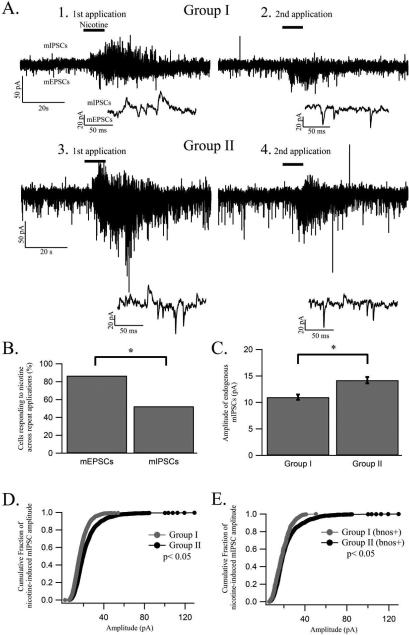Figure 5.
Nicotine elicits increases in frequency and amplitude of mEPSC and mIPSC and induces differential increases in mIPSC amplitude across ontogeny. (A) Representative whole cell, voltage clamp recordings showing first and second nicotine (black line) mediated elicitations of mEPSCs and mIPSCs from a cholinergic LDT neuron from group I (A1 and A2) and group II (A3 and A4). In the bottom of each recording a representative inset of a part of the recording during nicotine exposure is shown. The first nicotine application produced mEPSCs and mIPSCs in both cells shown, but a second application of nicotine in the same cells elicited a smaller proportion of mIPSCs as compared to mEPSCs in both age groups. (B) The percentage of cells responding to two nicotine applications with an increase in mEPSCs and mIPSCs across both applications is displayed in a histogram where a significantly larger proportion of cells show the appearance of mEPSCs as compared to mIPSCs suggesting that a longer recovery period is required for nicotine to induce repeat mIPSCs compared to mEPSCs. (C) Histogram showing the endogenous mIPSC amplitude in group I and group II indicating larger amplitude events occur in group II than in group I. (D) Nicotine induced significantly larger mIPSC amplitudes in cells from group II as compared to the amplitude induced in group I as illustrated by the cumulative fractions distribution of the amplitude of all nicotine-induced mIPSCs in group I (grey) and group II (black) for LDT cells responding to nicotine with a significant increase in amplitude. (E) The larger nicotine-mediated mIPSCs amplitude in group II as compared to group I extended to bnos positive LDT cells as indicated by the cumulative fractions distribution showing the amplitude of nicotine-induced mIPSCs from bnos positive cells from group I and group II.

